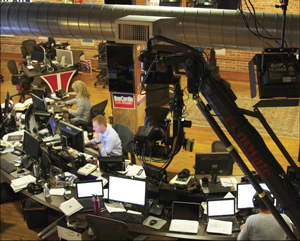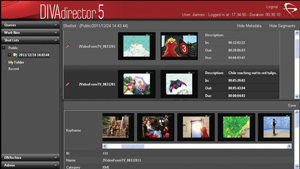Reporting Live From the Cloud

Current TV uses Primestream’s Fork media asset management and production control system as an integral part of its daily operations. HAMILTON, N.J.—Media asset management isn’t just about storing yesterday’s content, it’s about creating today’s content. And newsroom automation depends on having an efficient file-based workflow unified with asset management. If you can find that certain archival clip you’re looking for, it can give tonight’s breaking news story an informative historical dimension.
With today’s “story-centric” workflow, TV news reporters can take total creative control over every aspect and version of their stories from start to finish. In the field, they can acquire and edit footage as well as search and retrieve media assets from the station’s central archive. Vendors want to give field reporters access to all the resources they need to transmit stories ready for air, as if they never left the newsroom.
NEWS AND COFFEE TO GO
“There is an industry trend to get more reporters on the street, and to give them the ability to craft and transmit stories from remote locations,” said Cynthia Parrish, product manager, Digital Asset Management, for Harris Broadcast’s Denver office. “Reporters can now go out to cover stories with eversmaller cameras, duck into a Starbucks to edit them on a laptop, then transmit them using 4G cellular or other means. They can even search and retrieve media assets from the station’s archives and drop them into their stories.”
Two years ago, Harris recognized this emerging trend and focused its research and development on products that would support this workflow. One such product is News- Fish, which elevates iPhones and Droids to newsgathering devices. When used with Harris Invenio digital asset management, the NewsFish smartphone app enables users, even citizen journalists, to capture video, add metadata, and send it directly into a media operation’s digital asset management system.

Front Porch Digital’s DIVAdirector for DIVArchive “There may only be a few minutes during a TV newscast to present a local story, but there’s virtually unlimited space to tell it online,” said Parrish. “As mobile devices become increasingly common, broadcasters have a growing need to produce lots of media-rich news content— enriched with video from their digital asset libraries—to fill their online channels. Since Web outlets can take lower resolution video and proxy editing, it’s another reason why producing and uploading stories from Starbucks or other public places is an appealing option.”
REACH FOR THE CLOUDS
One way to empower broadcast journalists and reporters is to give them access to the station’s media library either from the newsroom computer system or a Web browser. To do this efficiently, Front Porch Digital suggests moving media assets up to the cloud—with its new Lynx cloud-based Content Storage System (CSM) service.
“Fast access to archival video clips can give a news story historical context and added value,” said Brian Campanotti, chief technical officer of Front Porch Digital in Lousiville, Colo. “But there’s a capital cost to digitizing, storing, and managing years of legacy footage, especially to buy, house, and maintain a robust storage infrastructure.”
Get the TV Tech Newsletter
The professional video industry's #1 source for news, trends and product and tech information. Sign up below.
Campanotti says FPD’s cloud-based service removes barriers to entry, like hardware, space, power and IT expertise needed to run storage infrastructures. “Irreplaceable media archives also benefit from scalability, guaranteed up-time, and disaster recovery. By putting their assets on the cloud, customers can access, expand, and protect their investment.”
Based on Front Porch Digital’s DIVArchive CSM system, Lynx offers globally diversified, redundant storage based on robotic data tape systems in a protected, secure environment. Users can also keep select content handy with LynxLocal, an edge appliance that synchronizes a user’s cloud-based content with a locally installed cache that offers a federated view of content stored locally and in the cloud.
ASSET-BASED WORKFLOW
When Avid introduced Interplay Sphere at this year’s NAB, the theme was to “break down the walls” to transform the newsroom into a virtual facility where everyone has real-time connectivity to the newsroom and access to centrally stored media assets regardless of their location or time zone. Sphere, which extends the Avid Interplay Production asset management family, employs a cloud-based architecture that gives remote NewsCutter or Media Composer users access to centrally stored media repositories and archives, and automated uploading of locally acquired footage.

Lloyd Carter, Head of Broadcast Technology, Media Division, for Australia’s Sky Racing, uses Grass Valley Stratus for a workflow integrated with asset management for faster, more efficient production for its TV, Internet and mobile platforms. “The top issue for broadcasters continues to be ‘how do we lower costs and increase efficiency’ to deliver more compelling, visually dynamic content to more screens simultaneously,” said Jim Frantzreb, senior segment manager for broadcast at Avid Technology in Burlington, Mass. “When an asset management system interoperates seamlessly with the other components in the production process, it becomes the key engine enabling faster, more productive workflows.
“Interplay Sphere users can search and retrieve media assets they need from the newsroom or remote locations as if they never left the newsroom,” Frantzreb continues. “They can also share media assets with other Interplay Production-connected users, and upload and download media in an automated way, without slowing editing down. This ‘asset-based workflow’ empowers reporters to produce news stories— with acquired footage interspersed with archival clips—and send back content ready for air or posting online.”
Avid has installed Interplay Production at over 1,200 sites globally and expects to begin shipping Sphere by the end of third quarter.
MORE EFFICIENT WORKFLOW
Grass Valley Stratus works with Grass Valley K2 Summit media servers and storage to provide unified media asset management and device control supporting news and studio workflows. It focuses on ingest, editing, and play-out and simplifies production involving large volumes of assets.
“The true value of media asset management comes from the ability to take advantage of those resources throughout the workflow, and streamline time-consuming tasks, like managing ingest, metadata, and transcoding—that hamper the creative process,” said Ed Casaccia, senior director segment marketing for Grass Valley in Sacramento, Calif. “Wherever reporters are working, it enables them to create a really solid finished piece that’s as good as they could’ve done in the newsroom.”
Sky Racing, an Australian network that covers tens of thousands of greyhound and harness racing events annually, was among the first to choose Stratus for a workflow integrated with asset management for faster, more efficient production for its TV, Internet and mobile platforms.
INCREASING PRODUCTIVITY
Many station groups such as Raycom, Gannett, and Hearst use a Bitcentral Precisbased newsroom production workflow, and Bitcentral Oasis for asset management. Oasis allows access and sharing of centrally stored media assets from anywhere via its secure, private or public cloud-based architecture. KGET-TV17 in Bakersfield, Calif., is one of many stations using Bitcentral products to support broadcast and online news workflows.
“By streamlining the workflow and enabling better asset sharing and utilization, broadcast news organizations can cut out needless steps and refocus their resources and energies on better storytelling,” said Fred Fourcher, president, founder, and chief executive officer of Bitcentral in Newport Beach, Calif. “This means less repetition of news stories, more content for on-air and online outlets, and a more rewarding viewer experience.
“To make the most of today’s file-based, story-centric workflow, stations should break out of the old ‘dub and feed’ mentality where the newsroom gets field footage and finishes stories in edit bays,” Fourcher said. “It’s more efficient to consider new approaches, like having reporters acquire, craft and finish their stories in the field, complete with archival footage, and send back packages ready to air.”
STAYING CURRENT
Current TV, the San Francisco-based progressive media network founded by Al Gore, uses Primestream’s Fork media asset management and production control system as an integral part of its daily operations.
Current TV produces 11 to 12 hours of live daily political talk and analysis, which feature timely, relevant news footage. Primestream’s Fork system helps ingest feeds, news clips, and other incoming video and tracks descriptive metadata. Current TV shows include “War Room with Jennifer Granholm,” ��The Young Turks,” and “Viewpoint with Eliot Spitzer.”
“When video arrives electronically, we edit the content we’re interested in and turn it around quickly for use in our live shows,” said David Bohrman, president of Current TV. “Capturing and managing metadata is critical to efficiently managing media assets and automating key aspects of the news production workflow.”
Fork automates the news workflow including ingest, transcoding, proxy or craft editing, playout and archive. It integrates seamlessly within newsroom computer systems like Avid iNews and AP ENPS.
SOCIAL MEDIA CONNECTION
Maintaining a vibrant social media presence is increasingly important to promote broadcast channels, and incorporate viewer feedback and videos in stories and newscasts. At NAB, Ross Video, introduced Inception, a social media management tool that makes it easier to integrate social media assets—from platforms like Twitter, Facebook, and YouTube—seamlessly within the existing MOS-driven iNews and ENPS newsroom workflow.
Citytv, an Edmonton TV station owned by Rogers Media Group, was among the first to incorporate Inception into its newsroom production workflow.
“Inception gives broadcast journalists an easier way to handle incoming tweets, comments, video clips and other viewer assets right within the established newsroom workflow with the personnel they already have,” said Allan Pepper, marketing product manager for Ross Video in Iroquois, Ontario.
“There are tools to search, sift, and approve comments from Facebook, Twitter, and other social media platforms,” Pepper said. “It also gives broadcasters an efficient, automated way to publish video, tweets, and other posts to promote their brands using social media.”

